

Vertebrata Palasiatica ›› 2022, Vol. 60 ›› Issue (3): 212-248.DOI: 10.19615/j.cnki.2096-9899.220601
Received:2022-01-27
Online:2022-06-20
Published:2022-07-07
Contact:
* liujun@ivpp.ac.cn基金资助:CLC Number:
LIU Jun. On kannemeyeriiform dicynodonts from the Shaanbeikannemeyeria Assemblage Zone of the Ordos Basin, China. Vertebrata Palasiatica, 2022, 60(3): 212-248.
刘俊. 2022, 60(3): 212-248, 鄂尔多斯盆地陕北肯氏兽组合带的肯氏兽型二齿兽类. 古脊椎动物学报.
Add to citation manager EndNote|Ris|BibTeX
URL: https://www.vertpala.ac.cn/EN/10.19615/j.cnki.2096-9899.220601
| skull | skull basal length | lower jaw | postcranial bones | |
|---|---|---|---|---|
| Shaanbeikannemeyeria | ||||
| adult | ||||
| IGCAGS V3151) | nearly complete | 27 | absent | absent |
| IVPP V 60332) | incomplete | 31 | present | present |
| IVPP V 11674 | nearly complete | 24 | present | absent |
| IVPP V 11675 | incomplete | ~27 | present | absent |
| IVPP V 11677 | incomplete | 29 | present | absent |
| IVPP V 30728 | absent | absent | left humerus | |
| subadult | ||||
| IVPP V 11676 | nearly complete | 16 | present | scapula, humerus, clavicle |
| IVPP V 17904 | incomplete | ~21 | absent | absent |
| IVPP V 30725 | incomplete | ~14 | present | absent |
| IVPP V 30726 | incomplete | ~18 | present | nearly complete |
| juvenile | ||||
| IVPP V 30729* | incomplete | <10 | absent | absent |
| ?Parakannemeyeria | ||||
| IVPP V 30727 | absent | absent | partial skeleton | |
| IVPP V 30730* | absent | absent | partial skeleton |
Table 1 List of studied specimens in this paper (cm)
| skull | skull basal length | lower jaw | postcranial bones | |
|---|---|---|---|---|
| Shaanbeikannemeyeria | ||||
| adult | ||||
| IGCAGS V3151) | nearly complete | 27 | absent | absent |
| IVPP V 60332) | incomplete | 31 | present | present |
| IVPP V 11674 | nearly complete | 24 | present | absent |
| IVPP V 11675 | incomplete | ~27 | present | absent |
| IVPP V 11677 | incomplete | 29 | present | absent |
| IVPP V 30728 | absent | absent | left humerus | |
| subadult | ||||
| IVPP V 11676 | nearly complete | 16 | present | scapula, humerus, clavicle |
| IVPP V 17904 | incomplete | ~21 | absent | absent |
| IVPP V 30725 | incomplete | ~14 | present | absent |
| IVPP V 30726 | incomplete | ~18 | present | nearly complete |
| juvenile | ||||
| IVPP V 30729* | incomplete | <10 | absent | absent |
| ?Parakannemeyeria | ||||
| IVPP V 30727 | absent | absent | partial skeleton | |
| IVPP V 30730* | absent | absent | partial skeleton |
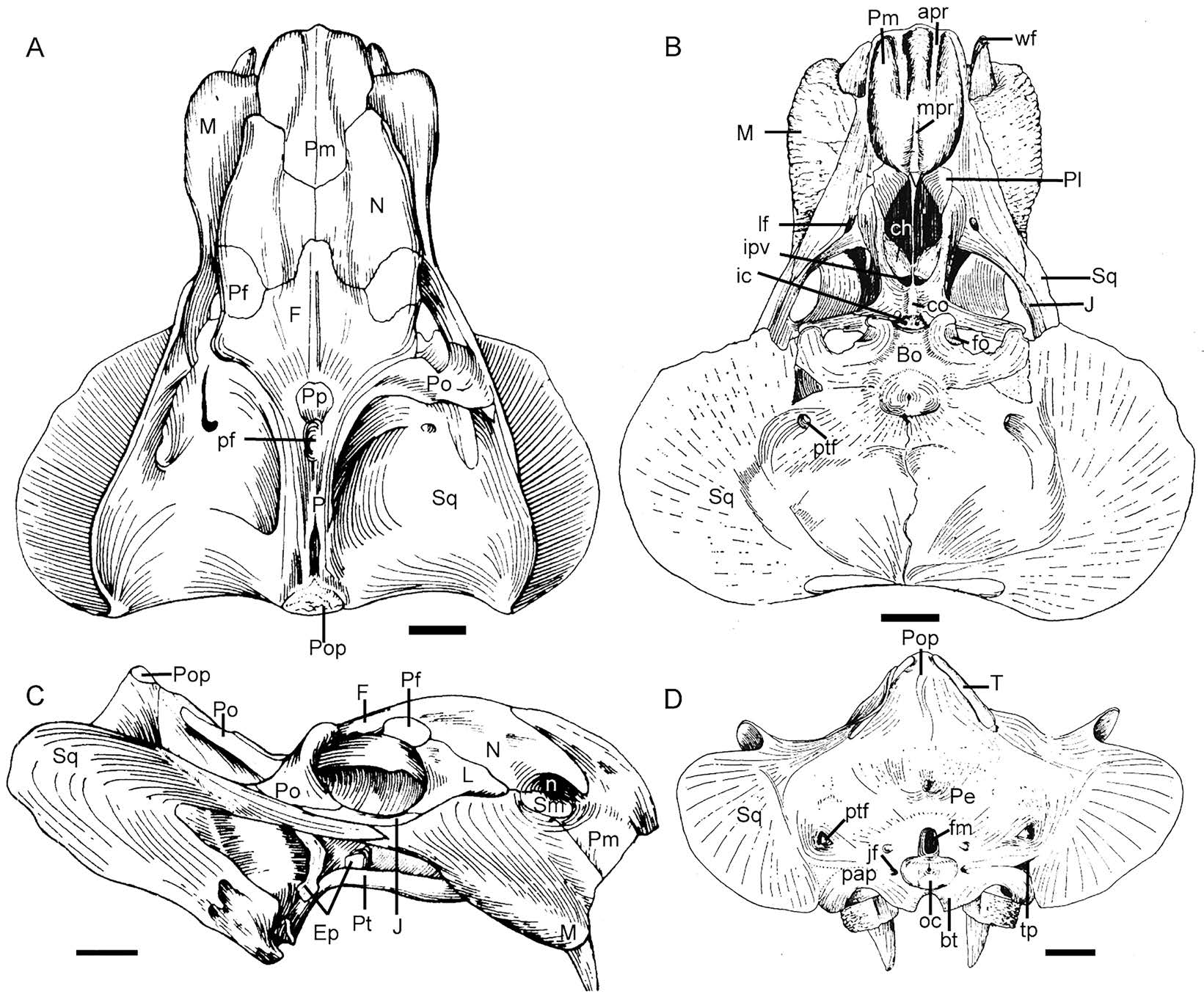
Fig. 2 Holotype of Shaanbeikannemeyeria xilougouensis (IGCAGS V315) from the Ermaying Formation Drawings of the skull in dorsal (A), ventral (B), lateral (C), and occipital (D) views Revised from Cheng, 1980. Scale bars equal 4 cm
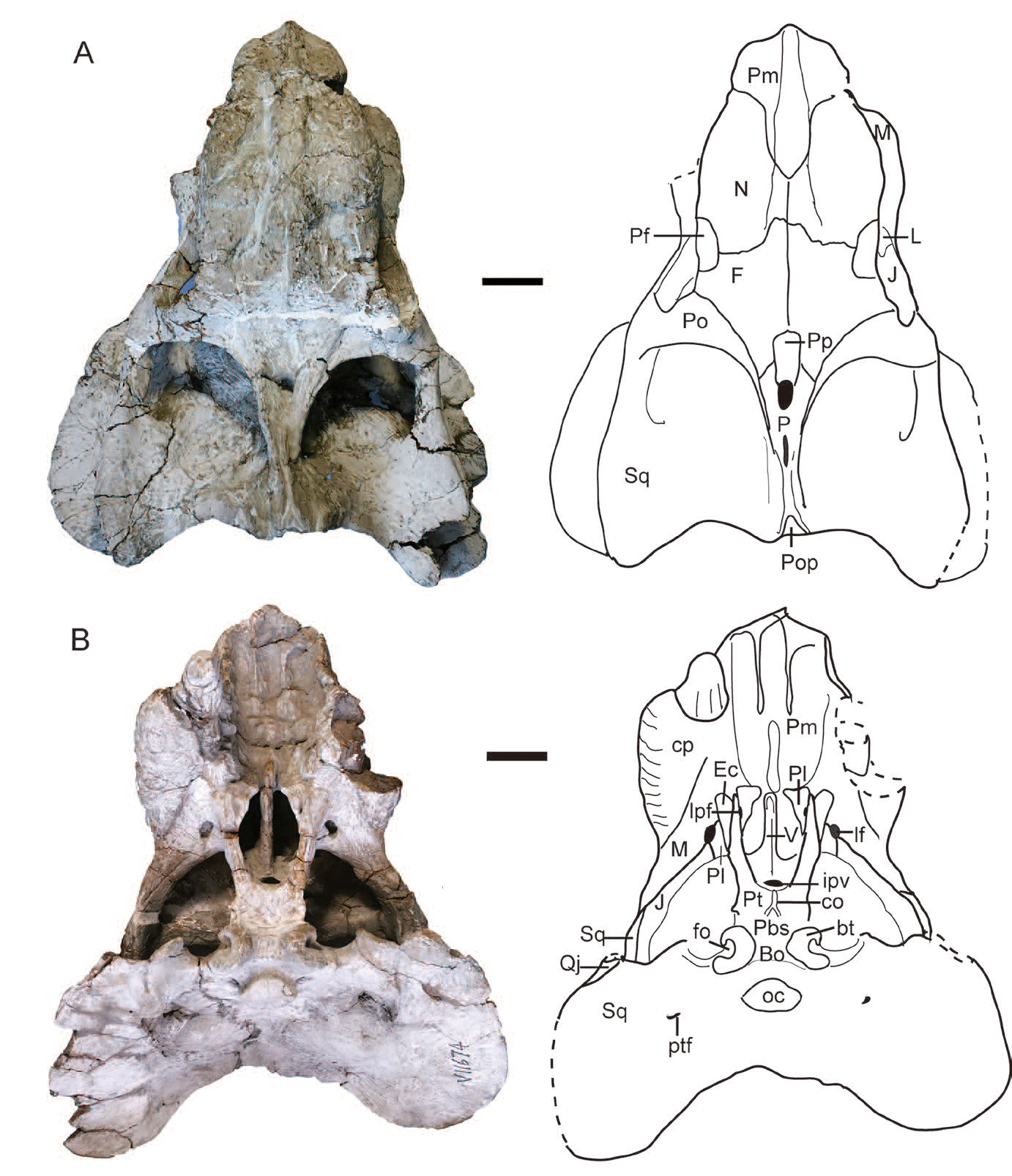
Fig. 3 Shaanbeikannemeyeria xilougouensis from the Ermaying Formation (IVPP V 11674) Skull: photos and interpretive drawings in dorsal (A) and ventral (B) views. Scale bars equal 4 cm
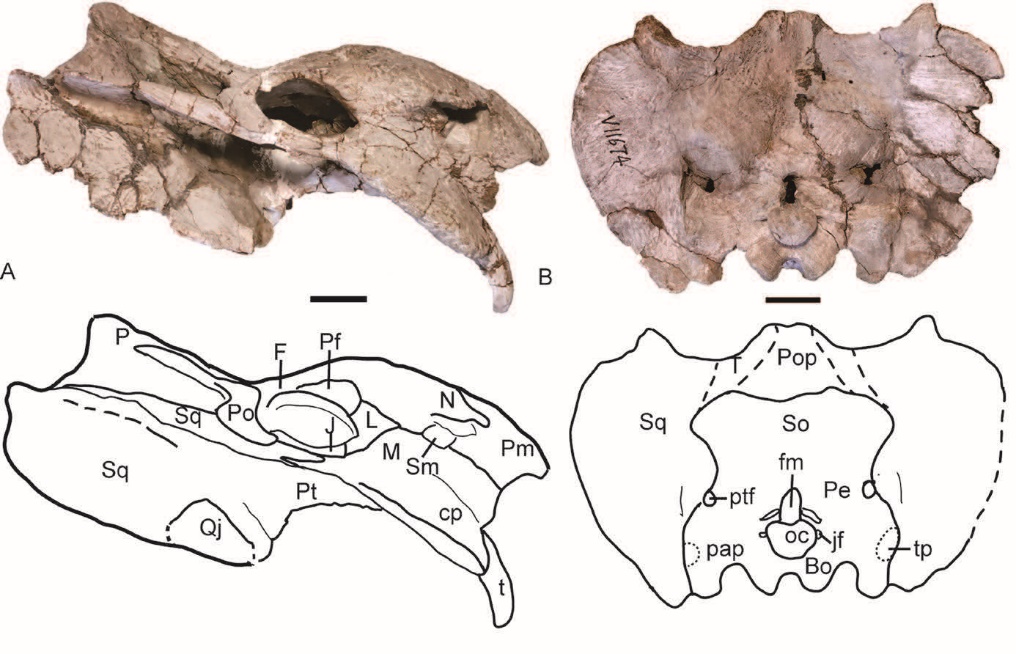
Fig. 4 Photos and interpretive drawings of the skull of Shaanbeikannemeyeria xilougouensis (IVPP V 11674) in right lateral (A) and occipital (B) views Scale bars equal 4 cm
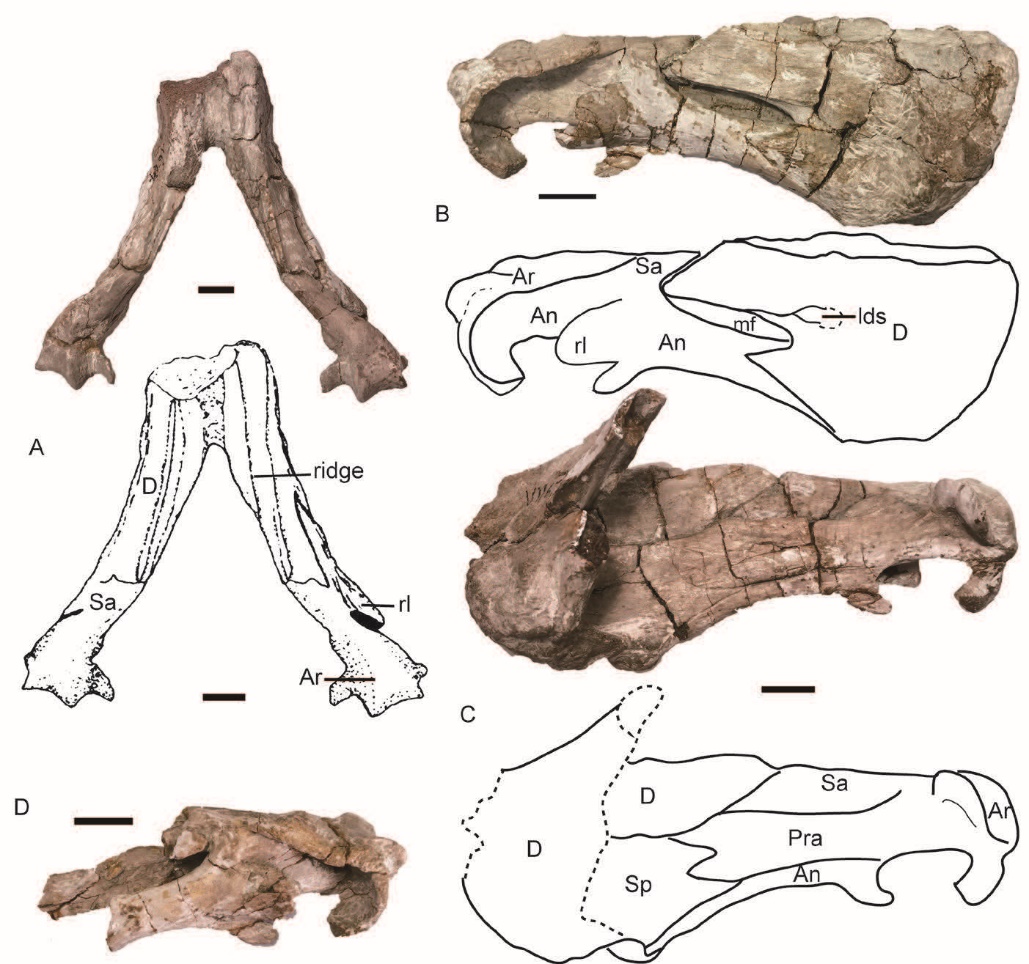
Fig. 5 Shaanbeikannemeyeria xilougouensis (IVPP V 11674), lower jaw, photo and interpretive drawing in dorsal (A), right lateral (B), and right medial (C) views; posterior portion of left ramus in lateral view (D) Scale bars equal 2 cm
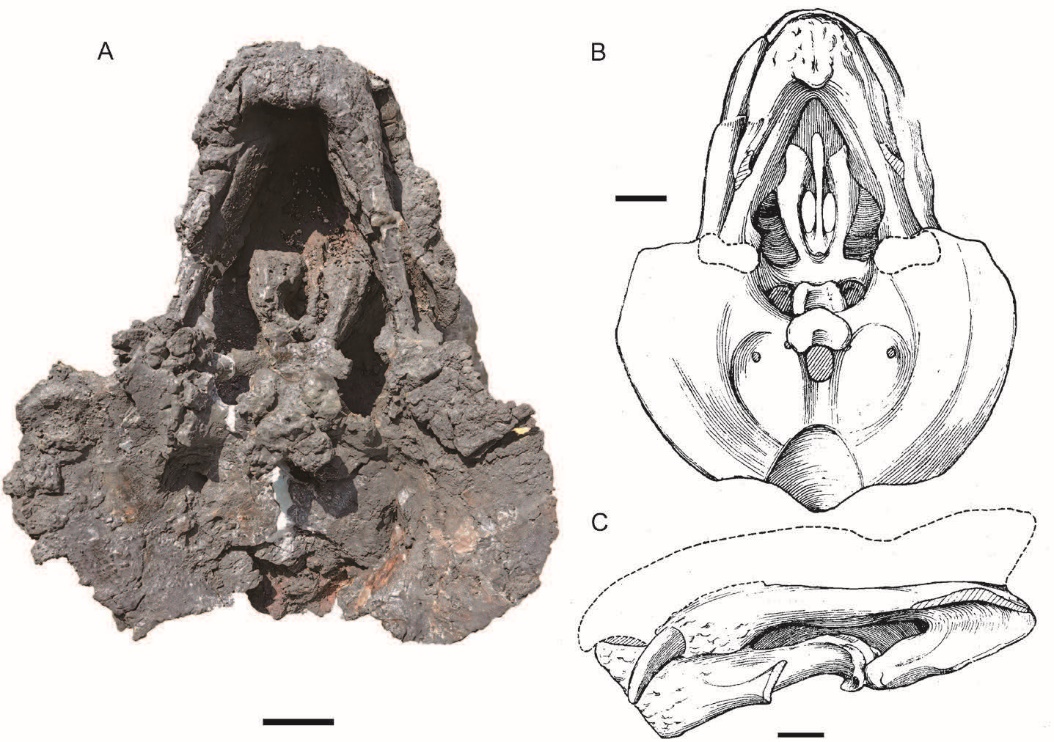
Fig. 6 Holotype of Shaanbeikannemeyeria buerdongia (IVPP V 6033) from the Ermaying Formation Skull with lower jaw: photo (A) and interpretive drawing (B) in ventral view, drawing (C) in left lateral view (drawing revised from Li, 1980). Scale bars equal 4 cm
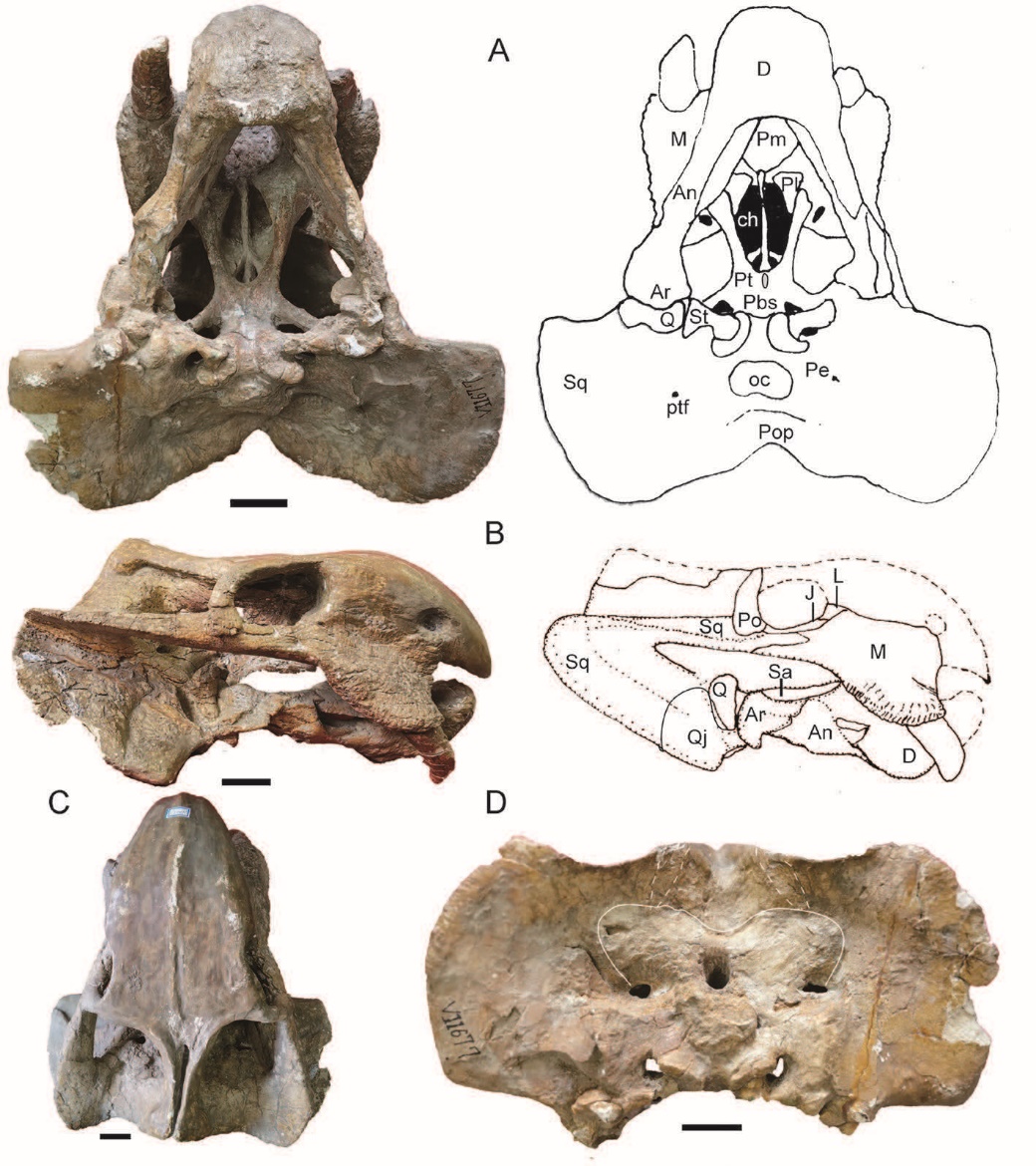
Fig. 7 Photos and drawings of the skull with lower jaw of Shaanbeikannemeyeria xilougouensis from the Ermaying Formation (IVPP V 11677) A. ventral view; B. right lateral view; C. dorsal view; D. occipital view. Scale bars equal 4 cm
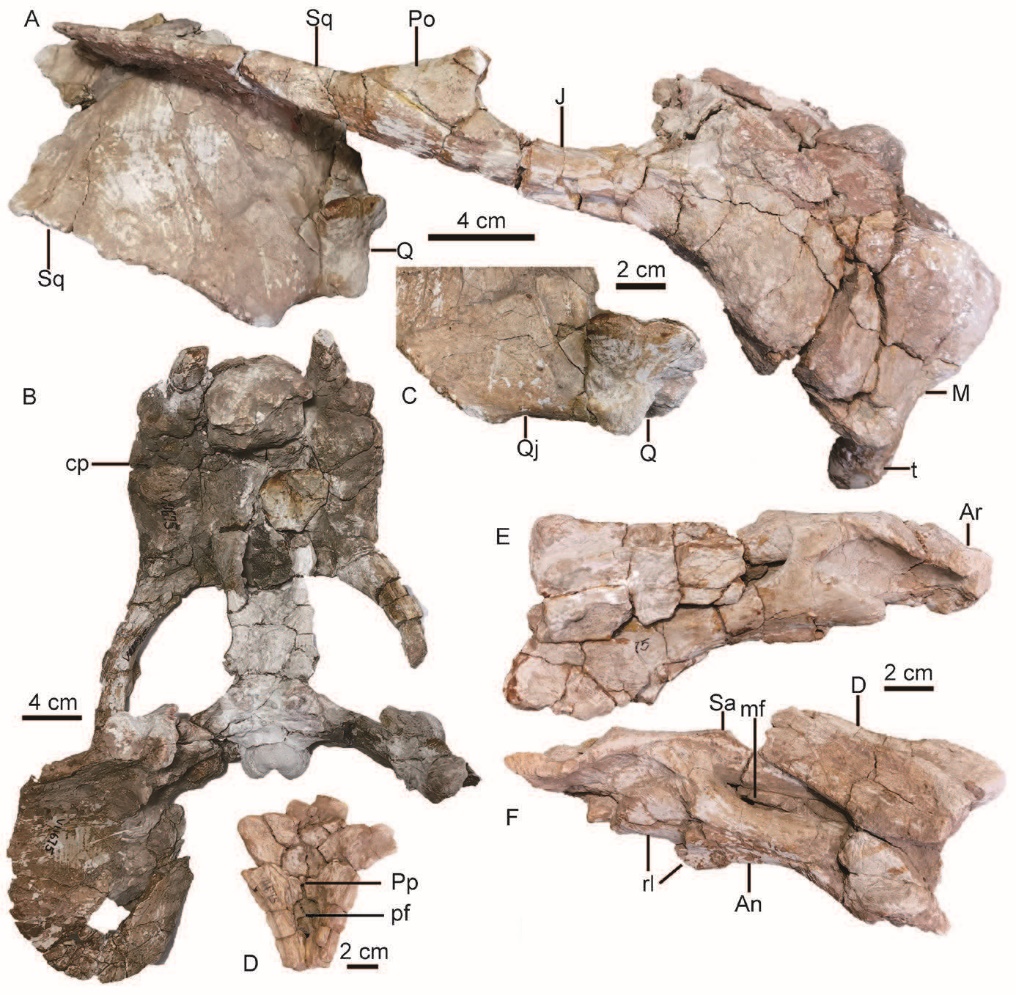
Fig. 8 Shaanbeikannemeyeria xilougouensis from the Heshanggou Formation (IVPP V 11675) A, B. skull in lateral (A) and ventral (B) views; C. quadrate and quadratojugal in anterolateral view; D. the region around the parietal foramen in dorsal view; E, F. lower jaw, part of the left ramus (E) and the right ramus (F) in lateral view
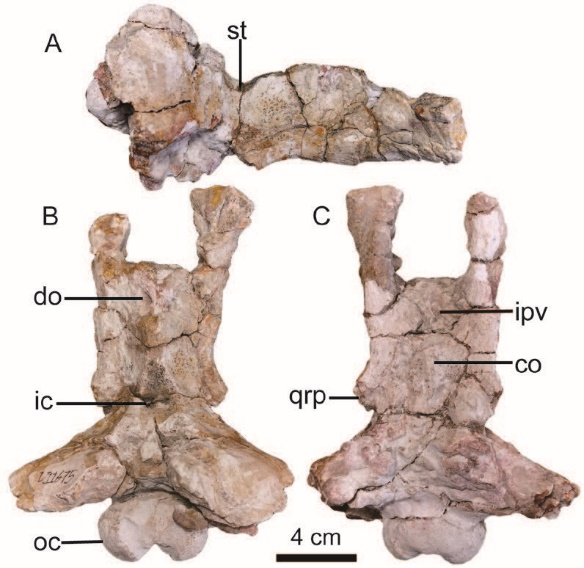
Fig. 9 Ventral-posterior portion of skull of Shaanbeikannemeyeria xilougouensis from the Heshanggou Formation (IVPP V 11675) in right lateral (A), dorsal (B) and ventral (C) views
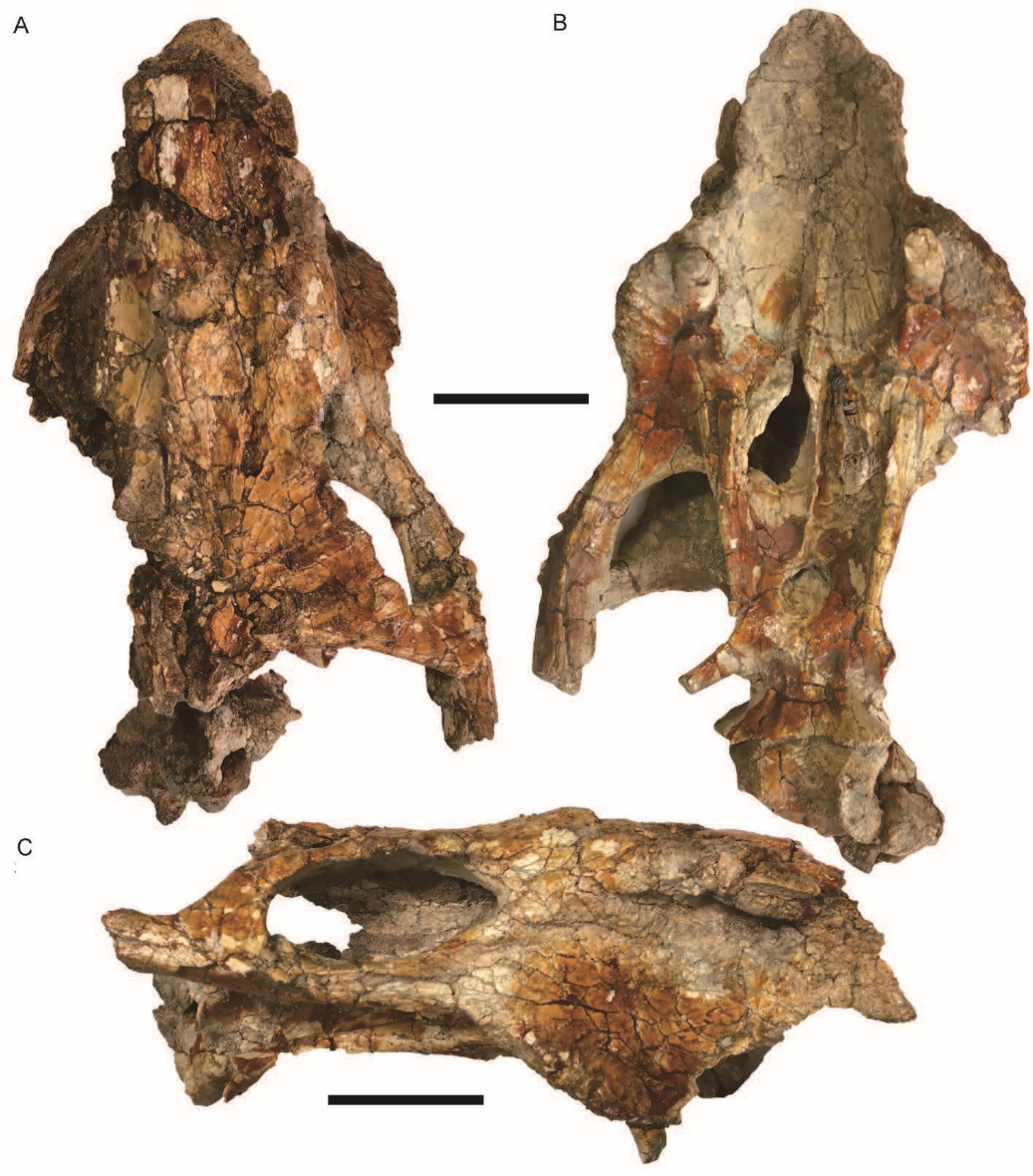
Fig. 10 Skull of Shaanbeikannemeyeria xilougouensis from the Ermaying Formation (IVPP V 17904) in dorsal (A), ventral (B), and right lateral (C) views Scale bars equal 4 cm
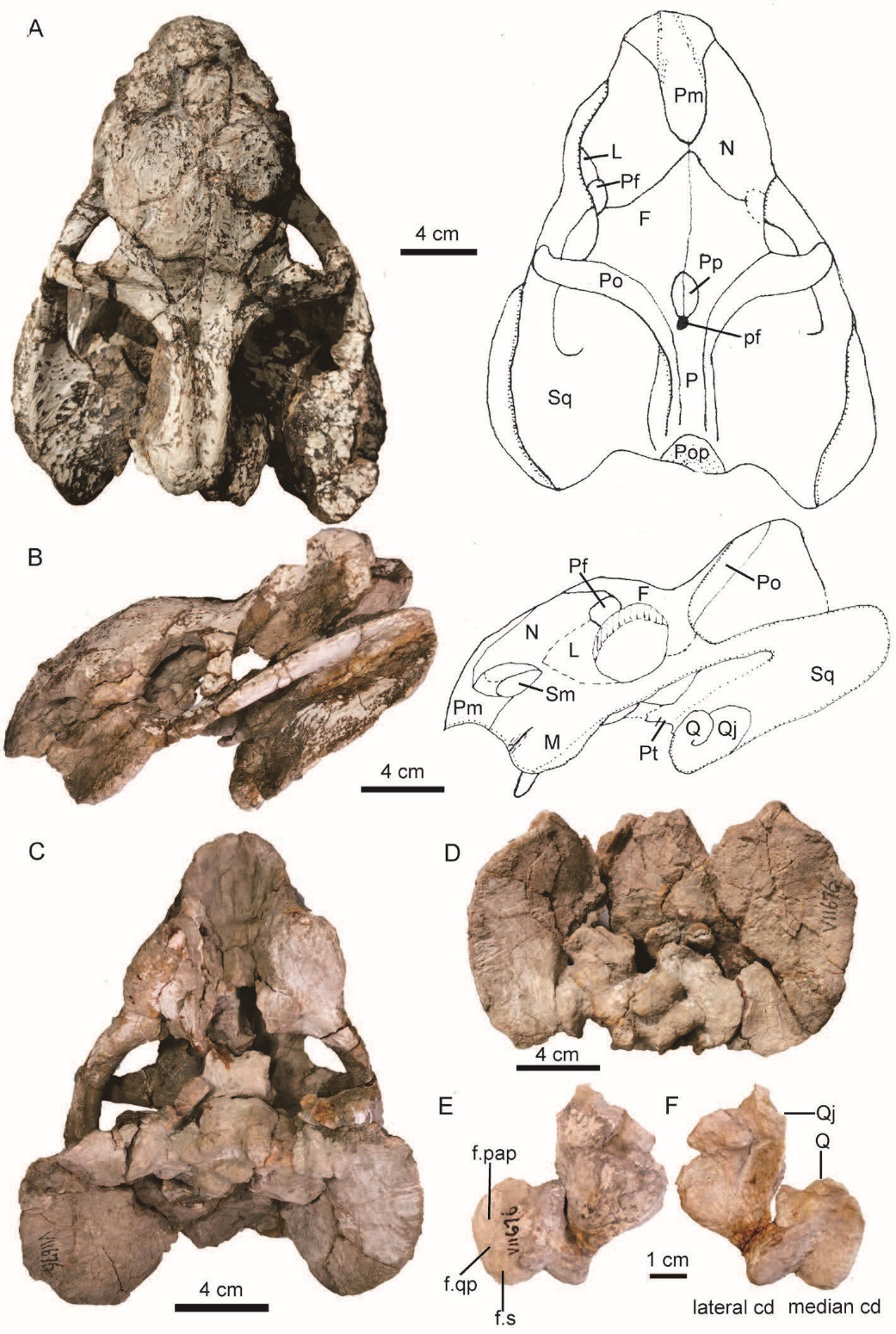
Fig. 11 Shaanbeikannemeyeria xilougouensis from the Ermaying Formation (IVPP V 11676) Photos and interpretive drawings of the skull in dorsal (A), right lateral (B), ventral (C) and occipital (D) views; left quadrate and quadratojugal complex in anterior (E) and posterior (F) views
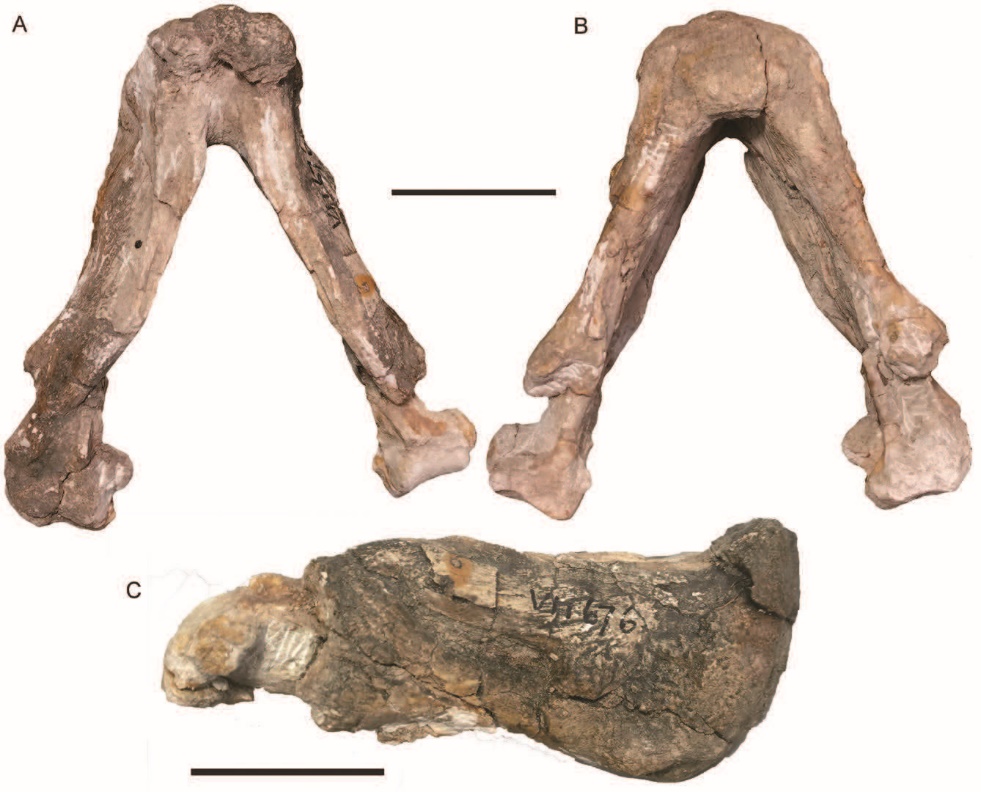
Fig. 12 Shaanbeikannemeyeria xilougouensis from the Ermaying Formation (IVPP V 11676) Lower jaw in dorsal (A), ventral (B) and right lateral (C) views. Scale bars equal 4 cm
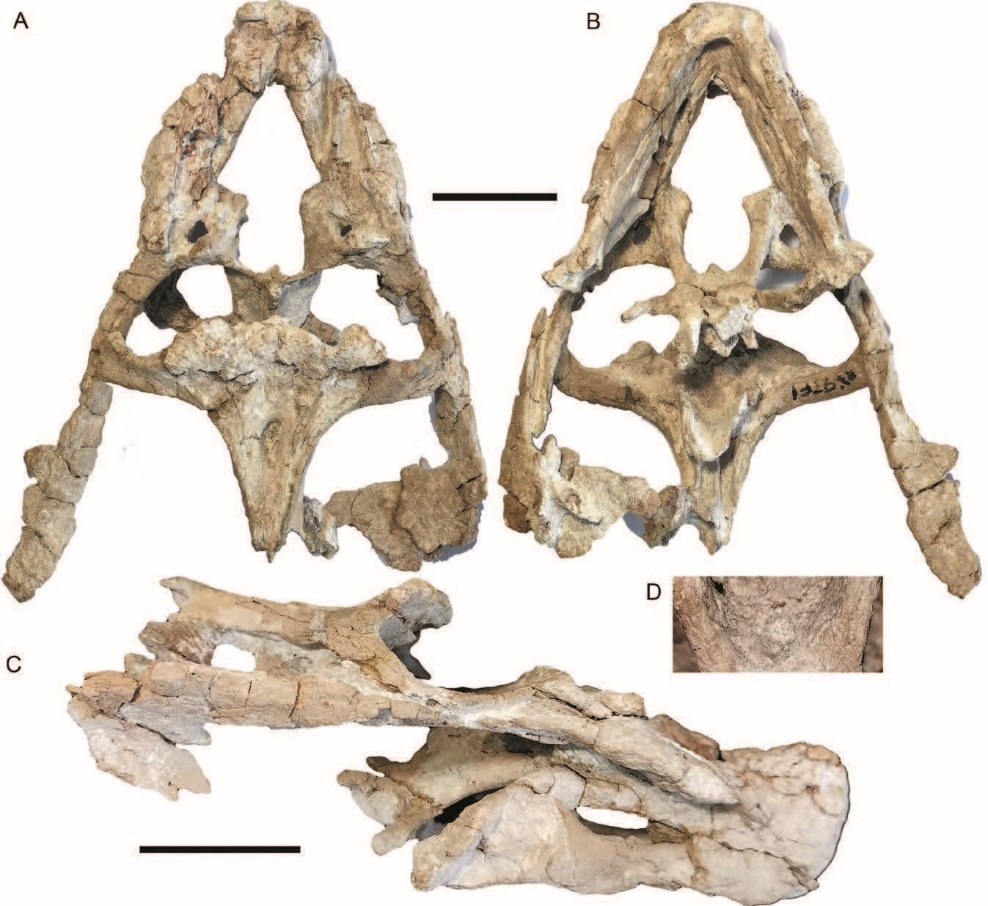
Fig. 13 Shaanbeikannemeyeria xilougouensis from the Ermaying Formation (IVPP V 30725) Incomplete skull with lower jaw in dorsal (A), ventral (B), and right lateral (C) views; part of the pterygoid showing the interpterygoid vacuity (D). Scale bars equal 4 cm
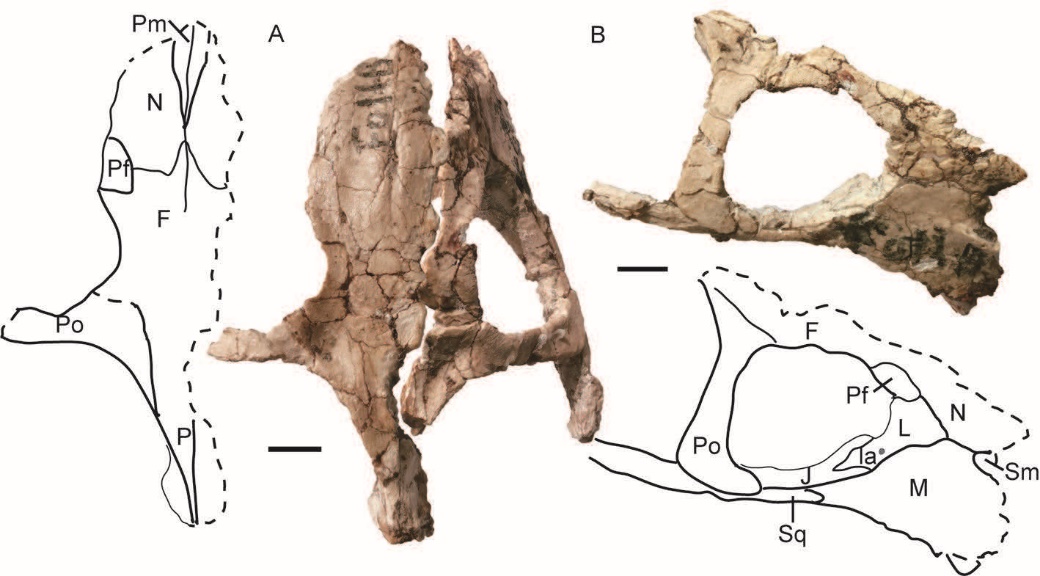
Fig. 14 Photos and interpretive drawings of the skull of Shaanbeikannemeyeria xilougouensis from the Ermaying Formation (IVPP V 30729) A. left portion in dorsal view; B. right portion in lateral and slightly dorsal view. Scale bars equal 1 cm
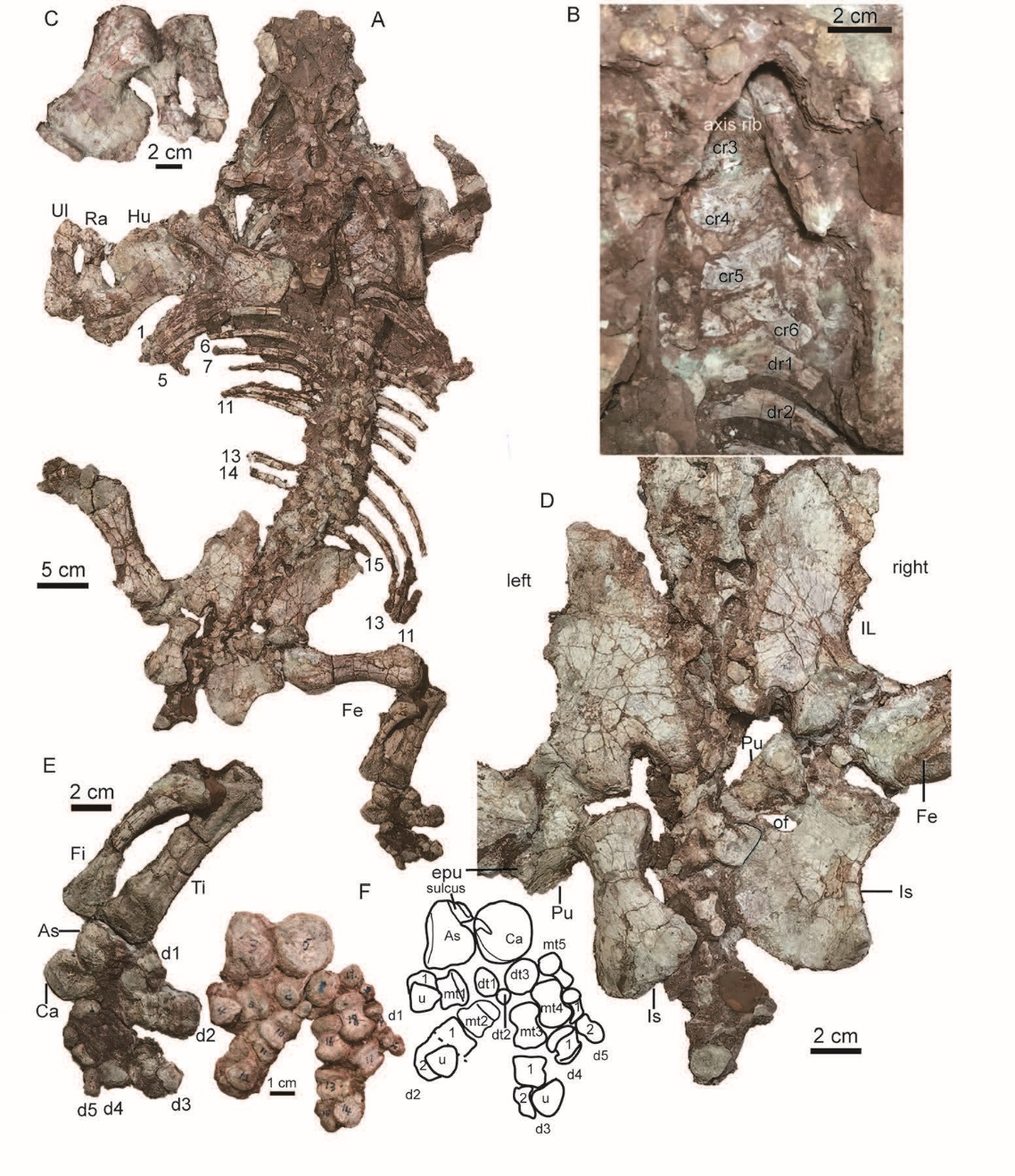
Fig. 15 Shaanbeikannemeyeria xilougouensis from the Ermaying Formation (IVPP V 30726) A. skeleton in dorsal view; B. right anterior presacral ribs; C. left forelimb, humerus in lateral and slightly dorsal view, ulna and radius in lateral view; D. left pelvic girdle in lateral view, right ilia in lateral view, right pubis and ischium in medial view; E. right hind limb, tibia and fibula in anterior view, pes in dorsal view; F. photo and drawing of right pes mainly in ventral view The numbers in (A) mark the dorsal ribs
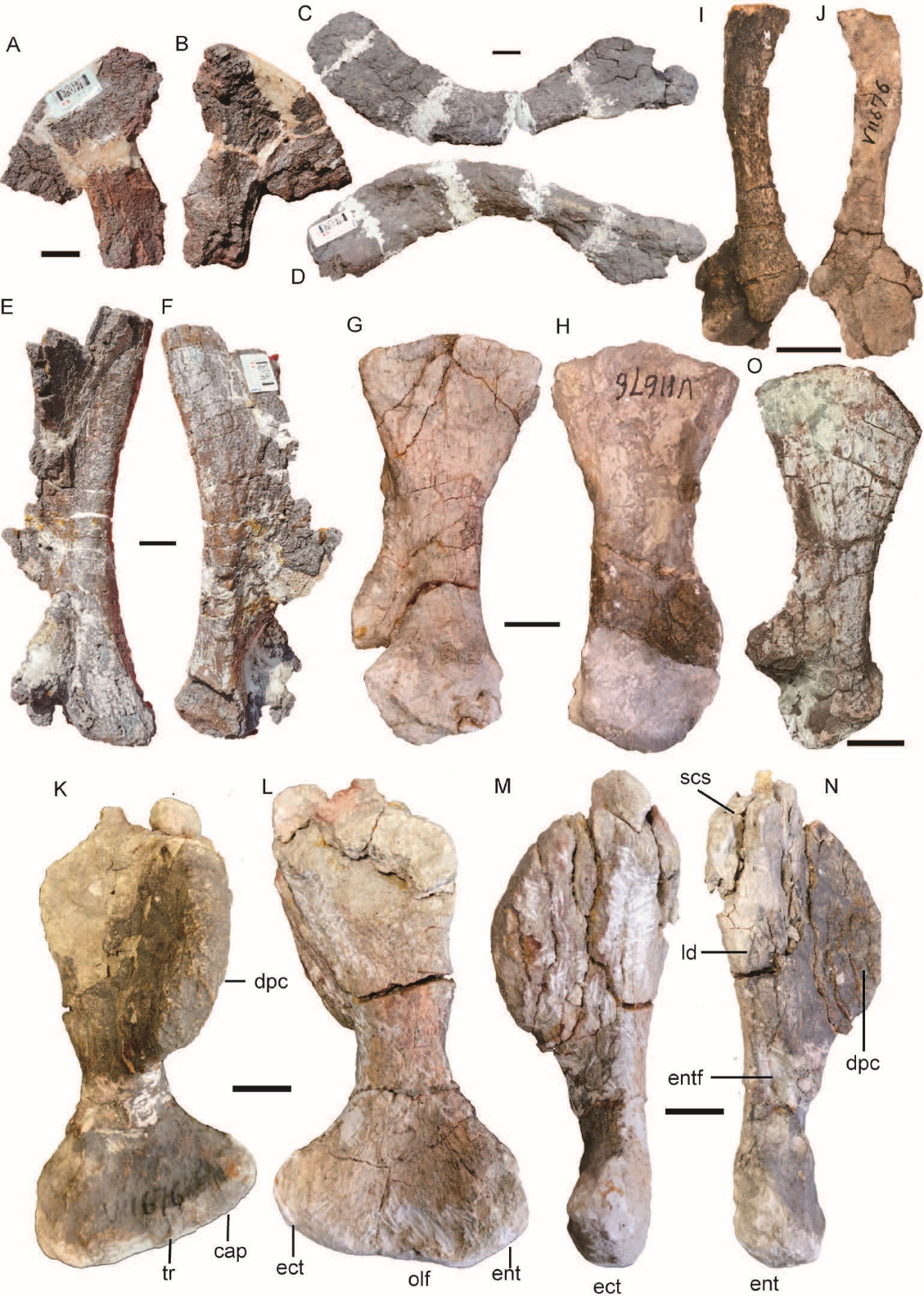
Fig. 16 Shaanbeikannemeyeria xilougouensis from the Ermaying Formation, postcranial bones IVPP V 6033: incomplete sternum in ventral (A) and dorsal (B) views; right clavicle in anterior (C) and posterior (D) views; right scapula in medial (E) and lateral (F) views IVPP V 11676: right scapula in medial (G) and lateral (H) views; right clavicle and interclavicle in ventral (I) and dorsal (J) views; left humerus in ventral (K), dorsal (L), anterior (M) and posterior (N) views IVPP V 30726: left scapula in lateral view (O). Scale bars equal 2 cm
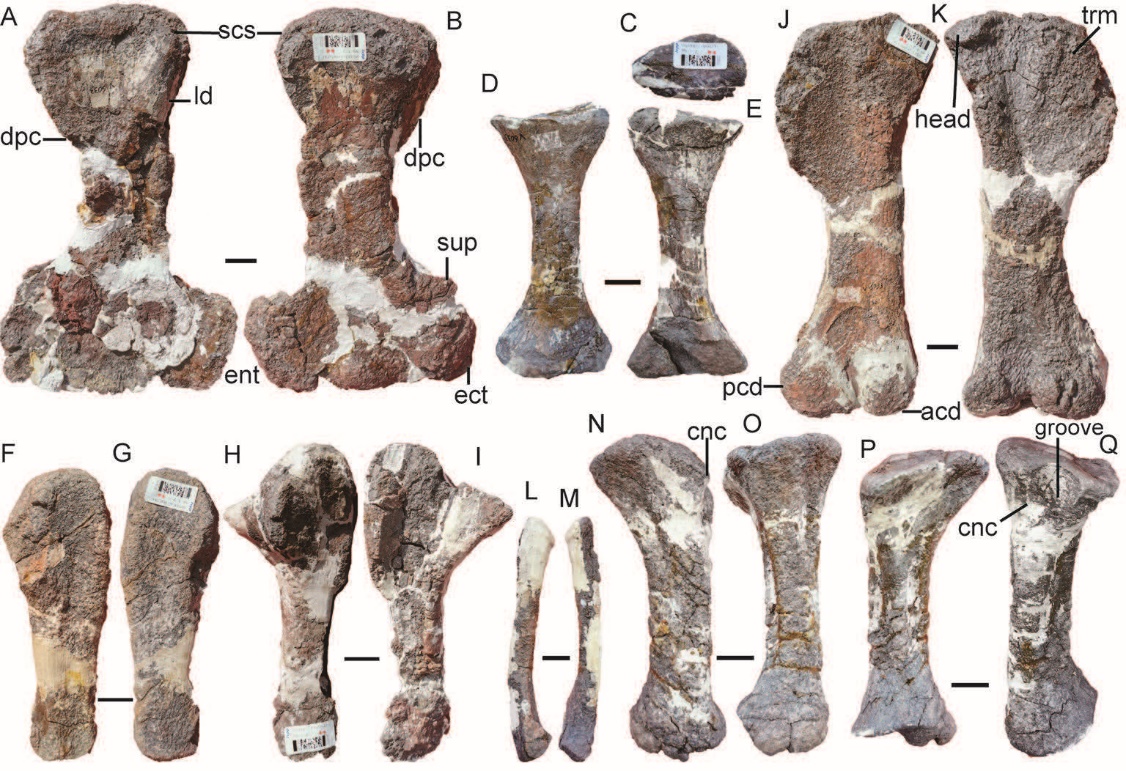
Fig. 17 Shaanbeikannemeyeria xilougouensis from the Ermaying Formation (IVPP V 6033), limbs Right humerus in ventral (A) and dorsal (B) views; left radius in proximal (C), anterior (D) and posterior (E) views; right ulna in medial (F) and lateral (G) views; left ulna in lateral (H) and medial (I) views; left femur in ventral (J) and dorsal (K) views; fibula in medial (L) and lateral (M) views; left tibia in anterior (N), medial (O), posterior (P) and lateral (Q) views. Scale bars equal 2 cm
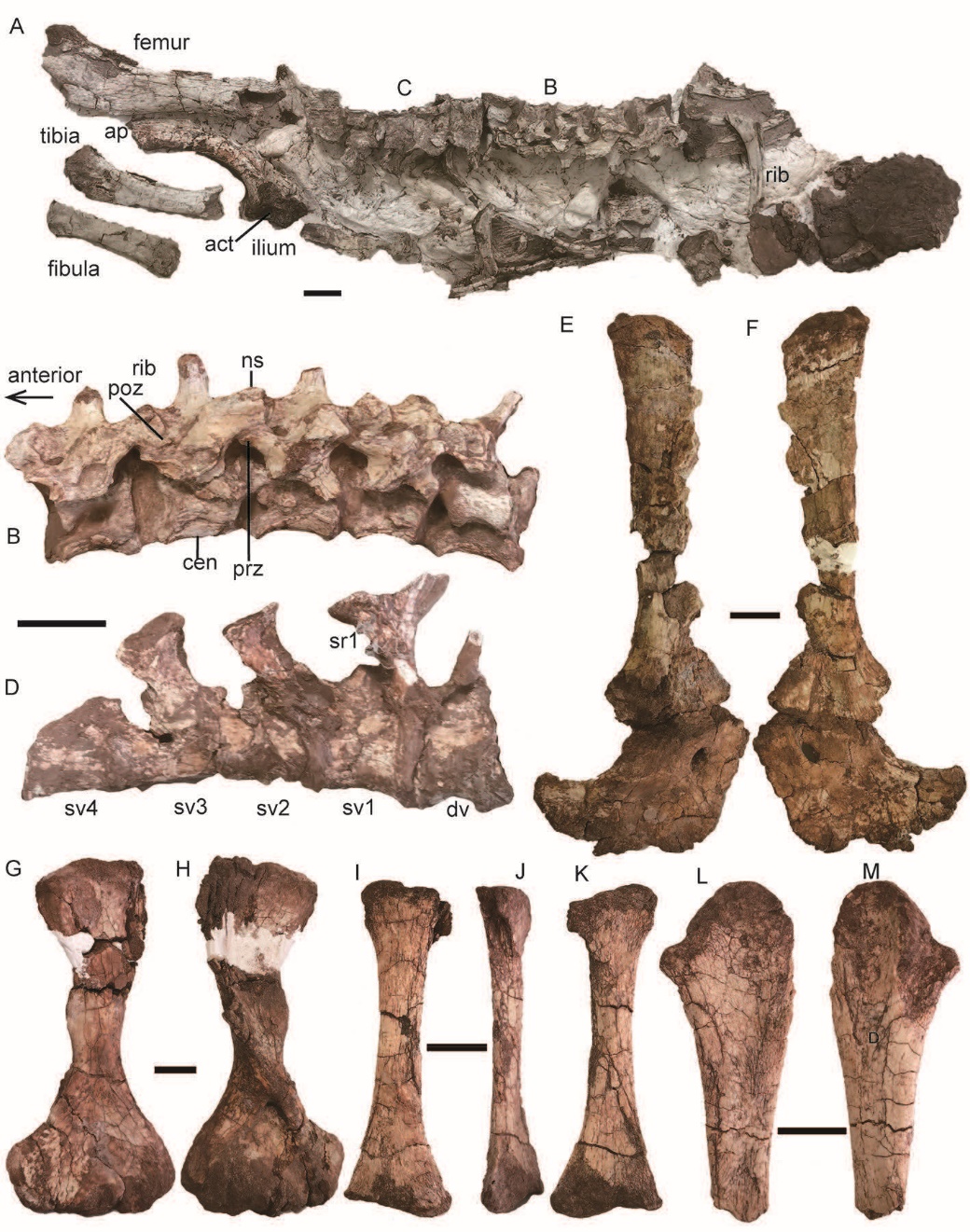
Fig. 18 ?Parakannemeyeria from the lower portion of the Ermaying Formation IVPP V 30730: A. partial posterior skeleton in dorsal view; B. five dorsal vertebrae and associated ribs in left dorsolateral view; C, D. last dorsal vertebra and four sacral vertebrae and associated ribs in left dorsolateral (C) and ventral (D) views IVPP V 30727: E, F. right scapula, procoracoid and metacoracoid in lateral (E) and medial (F) views; G, H. right humerus in dorsal (G) and ventral (H) views; I-K. right radius in anterior (I), medial (J), and posterior (K) views; L, M. right ulna in posterior (L) and anterior (M) views. Scale bars equal 2 cm
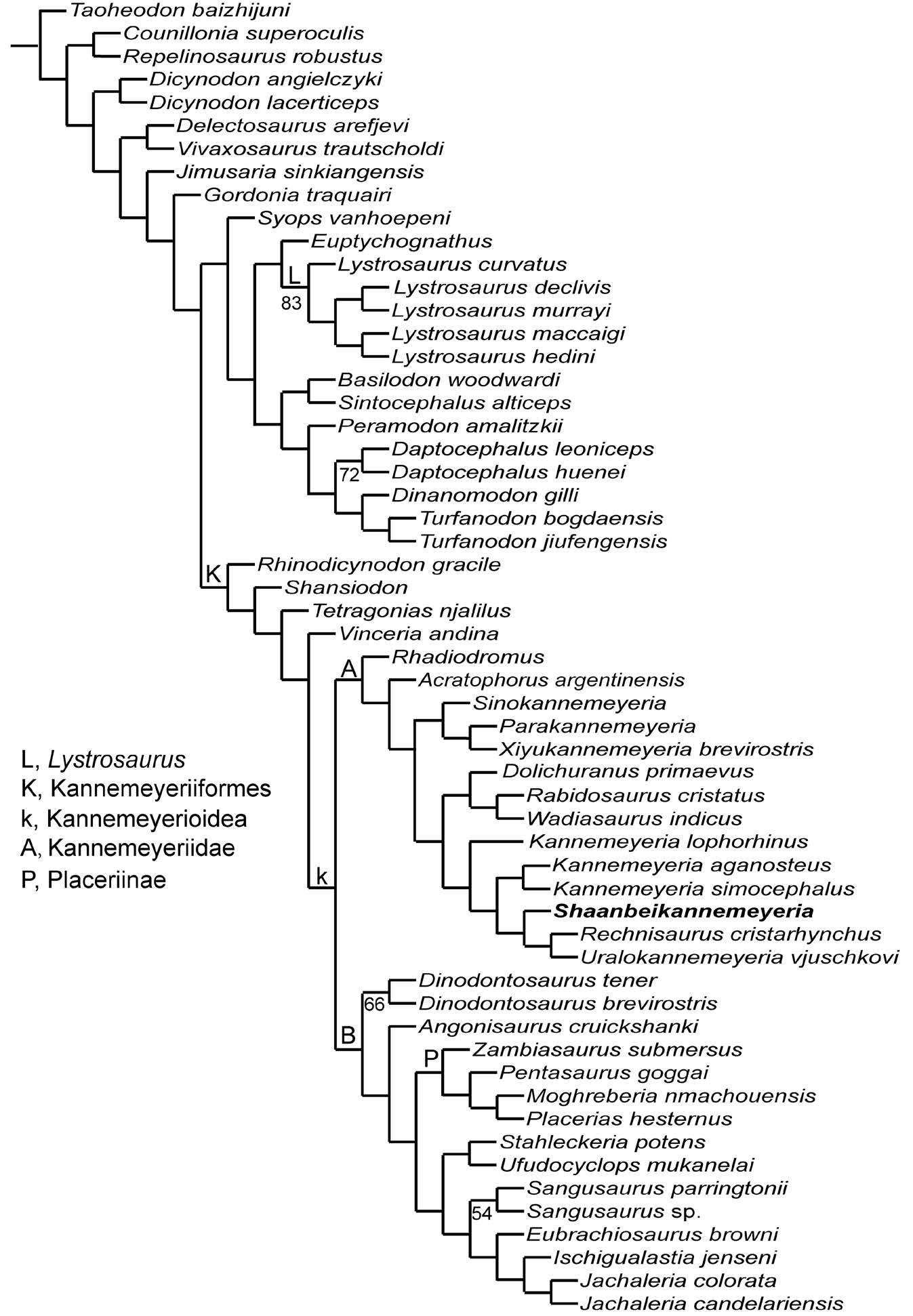
Fig. 19 Results of the phylogenetic analysis, showing the interrelationships within Dicynodontoidea Numbers below nodes represent symmetric resampling values
| ratio of occipital width/height | snout tip | orbital portion of the zygomatic arch | caniniform process | |
|---|---|---|---|---|
| IGCAGS V315 | 1.22 | obtuse | rod-like | flat |
| IVPP V 11674 | 1.20 | sharp | nearly flat dorsoventrally | flat |
| IVPP V 6033 | 1.61 | nearly flat dorsoventrally | rounded | |
| IVPP V 11675 | rod-like | rounded | ||
| IVPP V 11676 | 1.27 | obtuse | rod-like | undeveloped |
| IVPP V 11677 | 1.54 | sharp | rod-like | rounded |
Table 2 Variations of some cranial features among different specimens
| ratio of occipital width/height | snout tip | orbital portion of the zygomatic arch | caniniform process | |
|---|---|---|---|---|
| IGCAGS V315 | 1.22 | obtuse | rod-like | flat |
| IVPP V 11674 | 1.20 | sharp | nearly flat dorsoventrally | flat |
| IVPP V 6033 | 1.61 | nearly flat dorsoventrally | rounded | |
| IVPP V 11675 | rod-like | rounded | ||
| IVPP V 11676 | 1.27 | obtuse | rod-like | undeveloped |
| IVPP V 11677 | 1.54 | sharp | rod-like | rounded |
| [1] |
Angielczyk K D, Hancox P J, Nabavizadeh A, 2017. A redescription of the Triassic kannemeyeriiform dicynodont Sangusaurus (Therapsida, Anomodontia), with an analysis of its feeding system. J Vert Paleont, 37(sup1): 189-227
DOI URL |
| [2] |
Angielczyk K D, Liu J, Yang W, 2021. A redescription of Kunpania scopulusa, a bidentalian dicynodont (Therapsida, Anomodontia) from the ?Guadalupian of northwestern China. J Vert Paleont, 41(1): e1922428
DOI URL |
| [3] | Araújo D C, Gonzaga T D, 1980. Uma Nova especie de Jachaleria (Therapsida, Dicynodontia) do Triassico do Brasil. Actas Segundo Congr Argent Paleontol Bioestratigr Primer Congr Latino Am Paleontol, 2(1): 159-174 |
| [4] | Bandyopadhyay S, 1988. A kannemeyeriid dicynodont from the Middle Triassic Yerrapalli Formation. Philos Trans R Soc Lond B Biol Sci, 320: 185-233 |
| [5] | Bandyopadhyay S, 1989. The mammal-like reptile Rechnisaurus from the Triassic of India. Palaeontology, 32(2): 305-312 |
| [6] | Bonaparte J F, 1969. Dos nuevas “faunas” de reptiles triásicos de Argentina. In: Amos A J ed.ed. Gondwana Stratigraphy, IUGS Symposium, Buenos Aires, 1-15. Paris: United Nations Educational Scientific and Cultural Organization. 283-306 |
| [7] | Cheng Z W, 1980. 7. Vertebrate fossils. In: IGCAGS ed.ed. Mesozoic Stratigraphy and Palaeontology of the Shaanxi-Gansu-Ninxia Basin. Beijing: Geological Publishing House. 115-188 |
| [8] |
Cox C B, 1959. On the anatomy of a new dicynodont genus with evidence of the position of the tympanum. Proc Zool Soc London, 132(3): 321-367
DOI URL |
| [9] | Cox C B, 1968. The Chañares (Argentina) Triassic reptile fauna; IV, The dicynodont fauna. Breviora, 295: 1-27 |
| [10] | Cox C B, 1969. Two new dicynodonts from the Triassic Ntawere Formation, Zambia. Bull Br Mus Nat Hist Geol, 17: 257-294 |
| [11] | Cox C B, 1991. The Pangaea Dicynodont Rechnisaurus and the comparative biostratigraphy of Triassic dicynodont faunas. Palaeontology, 34: 767-784 |
| [12] | Cox C B, Li J L, 1983. A new genus of Triassic dicynodont from East Africa and its classification. Palaeontology, 26: 389-406 |
| [13] |
Cruickshank A R I, 1967. A new Dicynodont genus from the Manda Formation of Tanzania (Tanganyika). J Zool, 153: 163-208
DOI URL |
| [14] |
Damiani R J, Vasconcelos C, Renaut A et al., 2007. Dolichuranus primaevus (Therapsida: Anomodontia) from the Middle Triassic of Namibia and its phylogenetic relationships. Palaeontology, 50: 1531-1546
DOI URL |
| [15] | Danilov A I, 1971. A new dicynodont from the Middle Triassic of southern Cisuralia. Paleontol J, 5(2): 265-268 |
| [16] |
Domnanovich N S, Marsicano C A, 2012. The Triassic dicynodont Vinceria (Therapsida, Anomodontia) from Argentina and a discussion on basal Kannemeyeriiformes. Geobios, 45(2): 173-186
DOI URL |
| [17] | Dutuit J M, 1988. Ostéologie crânienne et ses enseignements, apports géologique et paléoécologique, de Moghreberia nmachouensis, Dicynodonte (Reptilia, Therapsida) du Trias supérieur marocain. Bull Mus Natn Hist Nat, 3: 227-285 |
| [18] |
Goloboff P A, Catalano S, 2016. TNT, version 1.5, with a full implementation of phylogenetic morphometrics. Cladistics, 32: 221-238
DOI PMID |
| [19] | Govender R, 2005. Morphological and functional analysis of the postcranial anatomy of two dicynodont morphotypes from the Cynognathus assemblage zone of South Africa and their taxonomic implications. Ph. D thesis. Johannesburg: University of the Witwatersrand. 1-199 |
| [20] | Kalandadze N N, 1970. New Triassic kannemeyeriids from South Cisuralia. In: Flerov K K ed.ed. Materials on the Evolution of Terrestrial Vertebrates. Moscow: Nauka. 51-57 |
| [21] | Kammerer C F, 2018. The first skeletal evidence of a dicynodont from the lower Elliot Formation of South Africa. Palaeontol Afr, 52: 102-128 |
| [22] |
Kammerer C F, Ordoñez M d l A, 2021. Dicynodonts (Therapsida: Anomodontia) of South America. J South Am Earth Sci, 108: 103171
DOI URL |
| [23] |
Kammerer C F, Fröbisch J, Angielczyk K D, 2013. On the validity and phylogenetic position of Eubrachiosaurus browni, a kannemeyeriiform dicynodont (Anomodontia) from Triassic North America. PLoS ONE, 8(5): e64203
DOI URL |
| [24] |
Kammerer C F, Viglietti P A, Hancox P J et al., 2019. A new kannemeyeriiform dicynodont (Ufudocyclops mukanelai, gen. et sp. nov.) from Subzone C of the Cynognathus Assemblage Zone, Triassic of South Africa, with implications for biostratigraphic correlation with other African Triassic Faunas. J Vert Paleont, 39(2): e1596921
DOI URL |
| [25] | King G M, 1981. The postcranial skeleton of Robertia broomiana, an early dicynodont (Reptilia, Therapsida) from the South African Karoo. Ann S Afr Mus, 84(5): 203-231 |
| [26] | King G M, 1988. Anomodontia. Stuttgart: Gustav Fischer Verlag. 1-174 |
| [27] | Li J L, 1980. Kannemeyeria fossil from Inner Mongolia. Vert PalAsiat, 18(2): 94-99 |
| [28] | Li J L, Cheng Z W, 1995. A new Late Permian vertebrate fauna from Dashankou, Gansu, with comments on Permian and Triassic vertebrate assemblage zones of China. In: Sun A L, Wang Y Q eds. Sixth Symposium on Mesozoic Terrestrial Ecosystems and Biota, Short Papers. Beijing: China Ocean Press. 33-37 |
| [29] | Li J L, Liu J, 2015. Basal Synapsids. Palaeovertebrate Sinica, III(14): 1-105 |
| [30] | Liu J, 2015. New discoveries from the Sinokannemeyeria-Shansisuchus Assemblage Zone: 1. Kannemeyeriiformes from Shanxi, China. Vert PalAsiat, 53(1): 16-28 |
| [31] | Liu J, 2018. New progress on the correlation of Chinese terrestrial Permo-Triassic strata. Vert PalAsiat, 56(4): 327-342 |
| [32] |
Liu J, 2021. The tetrapod fauna of the upper Permian Naobaogou Formation of China: 6. Turfanodon jiufengensis sp. nov. (Dicynodontia). Peer J, 9: e10854
DOI URL |
| [33] | Liu J, Li J L, 2003. A new material of kannemeyerid from Xinjiang and the restudy of Parakannemeyeria brevirostris. Vert PalAsiat, 41(2): 147-156 |
| [34] | Liu J, Ramezani J, Li L et al., 2018. High-precision temporal calibration of Middle Triassic vertebrate biostratigraphy: U-Pb zircon constraints for the Sinokannemeyeria Fauna and Yonghesuchus. Vert PalAsiat, 56(1): 16-24 |
| [35] | Lucas S G, 2001. Chinese Fossil Vertebrates. New York: Columbia University Press. 1-375 |
| [36] |
Maisch M W, 2001. Observations on Karoo and Gondwana vertebrates. Part 2: A new skull-reconstruction of Stahleckeria potens von Huene, 1935 (Dicynodontia, Middle Triassic) and a reconsideration of kannemeyeriiform phylogeny. Neues Jahrb Geol Palaontol Abh, 220(1): 127-152
DOI URL |
| [37] | Morato L, 2006. Dinodontosaurus (Synapsida, Dicynodontia) reconstituições morfológicas e aspectos biomecânicos. Master thesis. Porto Alegre (RS): Universidade Federal do Rio Grande do Sul. 1-158 |
| [38] | Olson E C, 1944. Origin of mammals based upon cranial morphology of the therapsid suborders. Geol Soc Am Spec Pap, 55: 1-136 |
| [39] | Owen R, 1860. On the orders of fossil and recent Reptilia, and their distribution in time. Report of the Twenty-Ninth Meeting of the British Association for the Advancement of Science, 1859: 153-166 |
| [40] | Renaut A J, Hancox P J, 2001. Cranial description and taxonomic re-evaluation of Kannemeyeria argentinensis (Therapsida: Dicynodontia). Palaeontol Afr, 37: 81-91 |
| [41] |
Sullivan C, Reisz R R, 2005. Cranial anatomy and taxonomy of the Late Permian dicynodont Diictodon. Ann Carnegie Mus, 74(1): 45-75
DOI URL |
| [42] | Sun A L, 1960. On a new genus of kannemeyerids from Ningwu, Shanxi. Vert PalAsiat, 4(2): 67-80 |
| [43] | Sun A L, 1963. The Chinese kannemeyerids. Palaeont Sin, New Ser C, 17: 1-109 |
| [44] | Sun A L, 1978. Discovery of Parakannemeyeria from Xinjiang. Mem Inst Vert Paleont Paleoanthrop, Acad Sin, 13: 47-54 |
| [45] | Surkov M V, 2003. A new anomodont (Therapsida) from the Middle Triassic of the southern Fore-Urals. Paleontol J, 37(4): 425-431 |
| [46] | Vega-Dias C, Schultz C L, 2004. Postcranial material of Jachaleria candelariensis Araújo and Gonzaga 1980 (Therapsida, Dicynodontia), Upper Triassic of Rio Grande do Sul, Brazil. PaleoBios, 24(1): 7-31 |
| [47] | Vega-Dias C, Maisch M W, Schwanke C, 2005. The taxonomic status of Stahleckeria impotens (Therapsida, Dicynodontia): redescription and discussion of its phylogenetic position. Rev Bras Paleontol, 8(3): 221-228 |
| [48] | von Huene F F, 1935. Die fossilen Reptilien des südamerikanischen Gondwanalandes. Ergebnisse der Sauriergrabungen in Südbrasilien, 1928-1929. Ordnung Anomodontia. Munich: C. H. Beck’sche Verlagsbuchhandlung. 1-92 |
| [49] |
Williston S W, 1904. Notice of some new reptiles from the Upper Trias of Wyoming. J Geol, 12(8): 688-697
DOI URL |
| [50] |
Young C C, 1937. On the Triassic dicynodonts from Shansi. Bull Geol Soc China, 17: 393-411
DOI URL |
| Viewed | ||||||
|
Full text |
|
|||||
|
Abstract |
|
|||||
